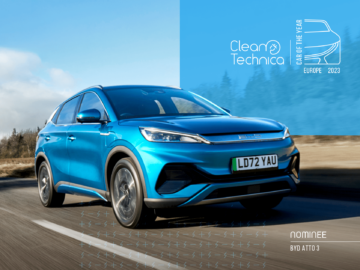
Sign up for daily news updates from CleanTechnica on email. Or follow us on Google News!
In 2022, 40,000 Americans died in motor vehicle accidents. The National Safety Council estimates about a third of those deaths were related to excessive speed. The National Highway Traffic Safety Administration says another third of all accidents are related to driving drunk or impaired by drugs. No doubt, some of those speeding deaths also involve drinking or drugs, so it can be argued that about half of all traffic deaths could be avoided if we got drunks and speeders off the road.
Last year, following a multi-car pile up near Las Vegas that killed nine people, the National Transportation Board recommended that manufacturers add devices to warn drivers when they are exceeding the posted speed limit. California state senator Scott Wiener wants to take that idea one step further. According to Autoblog, he has filed a bill in the state legislature that would require cars and trucks sold in California to include speed governors that would prohibit motorists from driving more than 10 mph over posted speed limits. The law would affect all vehicles beginning in model year 2027.
The speed “governor” technology relies on GPS data or car cameras to cap vehicle speeds based on where the car is driving. It would prohibit vehicles from driving faster than 80 mph on state highways with a posted 70 mph speed. In residential neighborhoods, motorists would have to keep their speed below 35 mph on streets with 25 mph limits.
The bill exempts emergency vehicles, such as ambulances and fire trucks, from the speed governor requirement. The California Highway Patrol would have the discretion to disable speed governors on their vehicles, “provided that the vehicle’s use is reasonable and would not pose a public safety risk,” according to a bill fact sheet.
Also known as “Intelligent Speed Assistance,” some speed governors can use GPS technology or cameras to cap vehicle speeds based on where the car is driving. Several auto manufacturers, such as Hyundai, already offer speed governor features in their newest models, which some motorists utilize as a form of cruise control, according to the San Francisco Chronicle.
“We have speed limits, and they exist for a reason. And it’s perfectly reasonable to say you can’t travel more than 10 miles over the speed limit,” Wiener said. “That’s what this bill will do. It’s very reasonable, and it’s an idea whose time has come.”
Speed X Mass = Force
While speed is certainly a factor in many traffic fatalities, today’s cars and trucks are quite a bit heavier than they were just a decade ago. The IIHS, which conducts crash testing for the insurance industry, took note of that fact and revised its crash testing protocols last year. The device it uses to smash into vehicles in side impact testing used to weigh 3,000 lbs and travel at 31 mph. The new device is higher, to reflect the fact that vehicles have also gotten taller recently and it now weighs 4,200 lbs, which is the weight of a typical SUV today. The impact speed has also been raised to 37 mph to better reflect the typical speed at which most collisions occur.
Isaac Newton taught us years ago that speed multiplied by mass equals force. The changes in the IIHS testing protocols certainly prove that Newton was correct. IIHS engineers said the 6 mph increase in the speed of the testing device adds 42 percent more energy into the crash. Adding 1,200 pounds to the barrier adds another 40 percent more energy on top of that. In other words, despite crumple zones, multiple air bags, seat belts, and stronger passenger protection cells, traffic collisions today are significantly more violent than they used to be, which means more people get badly hurt or killed when cars collide. No wonder highway deaths are increasing.
Political Considerations
Plenty of people will view any such speed restricting devices as an infringement on our freedom, as if putting other drivers at risk of serious injury or death is a right guaranteed in the Constitution. We have developed a culture that associates motor vehicles and speed. Cops and robbers. Revenuers and moonshiners. Smokey And The Bandit, The Dukes of Hazzard, and The Cannonball Run. All of them celebrate our need for speed. The Mille Miglia in Italy was a car race that ran on public roads with people standing close to the speeding cars — until 1957 when a burst tire sent a Ferrari hurtling into the crowd, killing 9 nine spectators.
People can easily construct arguments for why they should be allowed to speed. What if they are having a heart attack and need to get to the hospital in a hurry? Some think they should be able to rush home to watch a football game or get to work on time. The number of excuses for speeding is almost infinite.
The glorification of drinking and driving has been part of automobile culture since the beginning. 100 years ago, real men liked to down a few glasses of wine before getting in their motorcars. “The red infuriator,” they called it. Older readers may recall this hit record by Nervous Norvus that celebrated the thrill of drunk driving.
[embedded content]
Plenty of people will see the idea of speed limiters as government overreach, the mark of the nanny state, and a plot by liberals to cancel our freedom to drive as we please.
Time To Stop The Killing
One of the problems with speed limiters is the speed limits themselves. Many of them are set for political reasons — to raise money for cities and towns — and ignore the advice of actual traffic engineers. So any discussion of speed limiting technology should include making speed limits that are reasonable and rational, not part of revenue raising schemes. If speed limits are realistic, why allow any tolerance at all?
Be that as it may, the technology is available today to tie vehicle speeds to the posted speed limit. Instead of spending hundreds of millions of dollars on autonomous driving systems that don’t work, why not put the technology we do have available to eliminate speeding and keep drunks from getting behind the wheel? Doing both would likely save 20,000 lives a year and untold numbers of serious injuries.
At first glance, the legislation proposed by Scott Wiener will offend lots of people. But maybe we need to adjust our thinking before we condemn it. It’s possible this is indeed an idea whose time has come.
Have a tip for CleanTechnica? Want to advertise? Want to suggest a guest for our CleanTech Talk podcast? Contact us here.
Latest CleanTechnica TV Video
[embedded content]
I don’t like paywalls. You don’t like paywalls. Who likes paywalls? Here at CleanTechnica, we implemented a limited paywall for a while, but it always felt wrong — and it was always tough to decide what we should put behind there. In theory, your most exclusive and best content goes behind a paywall. But then fewer people read it!! So, we’ve decided to completely nix paywalls here at CleanTechnica. But…
Thank you!
Advertisement
CleanTechnica uses affiliate links. See our policy here.
- SEO Powered Content & PR Distribution. Get Amplified Today.
- PlatoData.Network Vertical Generative Ai. Empower Yourself. Access Here.
- PlatoAiStream. Web3 Intelligence. Knowledge Amplified. Access Here.
- PlatoESG. Carbon, CleanTech, Energy, Environment, Solar, Waste Management. Access Here.
- PlatoHealth. Biotech and Clinical Trials Intelligence. Access Here.
- Source: https://cleantechnica.com/2024/01/28/speed-kills-are-we-ok-with-that/
- :has
- :is
- :not
- :where
- $UP
- 000
- 1
- 10
- 100
- 15%
- 20
- 200
- 2022
- 25
- 31
- 35%
- 36
- 40
- 70
- 80
- 9
- a
- Able
- About
- accidents
- According
- actual
- adding
- Adds
- adjust
- administration
- Advertise
- advice
- affect
- Affiliate
- ago
- AIR
- All
- allow
- allowed
- almost
- already
- also
- always
- Ambulances
- Americans
- an
- and
- Another
- any
- ARE
- argued
- arguments
- AS
- Assistance
- associates
- At
- attack
- auto
- automobile
- autonomous
- available
- avoided
- badly
- bags
- barrier
- based
- BE
- been
- before
- Beginning
- behind
- below
- BEST
- Better
- Bill
- Bit
- board
- both
- but
- by
- california
- called
- cameras
- CAN
- cap
- car
- cars
- celebrate
- celebrated
- Cells
- certainly
- Changes
- chip
- Chronicle
- Cities
- cleantech
- Cleantech Talk
- Close
- Collide
- come
- Companies
- completely
- conducts
- Constitution
- construct
- content
- control
- cops
- correct
- could
- Council
- Crash
- crowd
- cruise
- Culture
- data
- Death
- deaths
- decade
- decide
- decided
- Despite
- developed
- device
- Devices
- died
- discretion
- discussion
- do
- doing
- dollars
- don
- Dont
- doubt
- down
- drive
- drivers
- driving
- Drugs
- easily
- eliminate
- embedded
- emergency
- energy
- Engineers
- Equals
- estimates
- excessive
- Exclusive
- exist
- fact
- factor
- faster
- fatalities
- Features
- felt
- Ferrari
- few
- fewer
- filed
- Fire
- First
- following
- Football
- For
- Force
- form
- Francisco
- Freedom
- from
- further
- game
- get
- getting
- Glance
- glasses
- Goes
- got
- Government
- government overreach
- Governor
- governors
- gps
- guaranteed
- Guest
- Half
- Have
- having
- he
- Heart
- Heart Attack
- help
- here
- higher
- Highway
- highways
- Hit
- Home
- Hospital
- HTTPS
- Hundreds
- hundreds of millions
- Hurt
- Hyundai
- idea
- if
- ignore
- Impact
- implemented
- in
- In other
- include
- Increase
- increasing
- indeed
- industry
- infringement
- injury
- instead
- insurance
- insurance industry
- into
- involve
- IT
- Italy
- ITS
- jpg
- just
- Keep
- killing
- known
- LAS
- Las Vegas
- Last
- Last Year
- Law
- Legislation
- Legislature
- like
- likely
- likes
- LIMIT
- Limited
- limiting
- limits
- links
- Lives
- lots
- Making
- Manufacturers
- many
- mark
- Mass
- May..
- maybe
- means
- Media
- Men
- millions
- model
- models
- money
- more
- most
- Motor
- multiple
- multiplied
- National
- Near
- Need
- New
- Newest
- news
- Newton
- nine
- no
- note
- now
- number
- numbers
- occur
- of
- off
- offer
- older
- on
- ONE
- or
- Other
- our
- over
- overreach
- part
- People
- percent
- perfectly
- plato
- Plato Data Intelligence
- PlatoData
- player
- please
- plot
- podcast
- policy
- political
- pose
- possible
- posted
- pounds
- problems
- prohibit
- proposed
- protection
- protocols
- Prove
- public
- publish
- put
- Putting
- quite
- Race
- raise
- raised
- raising
- Rational
- Read
- Reader
- readers
- real
- realistic
- reason
- reasonable
- reasons
- recently
- recommended
- record
- Red
- reflect
- related
- require
- requirement
- residential
- restricting
- revenue
- right
- Risk
- road
- roads
- Run
- rush
- Safety
- Said
- Save
- say
- says
- schemes
- scott
- see
- Senator
- sent
- serious
- set
- several
- sheet
- should
- side
- significantly
- since
- Smash
- So
- sold
- some
- speed
- speeds
- Spending
- standing
- State
- Step
- Stop
- Stories
- streets
- stronger
- such
- suggest
- support
- Systems
- T
- Take
- Talk
- taught
- team
- Technology
- Testing
- than
- that
- The
- the Law
- The State
- their
- Them
- themselves
- then
- theory
- There.
- they
- Think
- Thinking
- Third
- this
- those
- thrill
- TIE
- time
- tip
- tire
- to
- today
- today’s
- tolerance
- took
- top
- tough
- towns
- traffic
- transportation
- travel
- Trucks
- tv
- typical
- until
- Untold
- Updates
- us
- use
- used
- uses
- utilize
- Ve
- VEGAS
- vehicle
- Vehicles
- very
- Video
- View
- want
- wants
- was
- Watch
- we
- weigh
- weighs
- weight
- were
- What
- Wheel
- when
- which
- while
- WHO
- whose
- why
- will
- WINE
- with
- wonder
- words
- Work
- would
- write
- Wrong
- X
- year
- years
- you
- Your
- youtube
- zephyrnet
- zones








